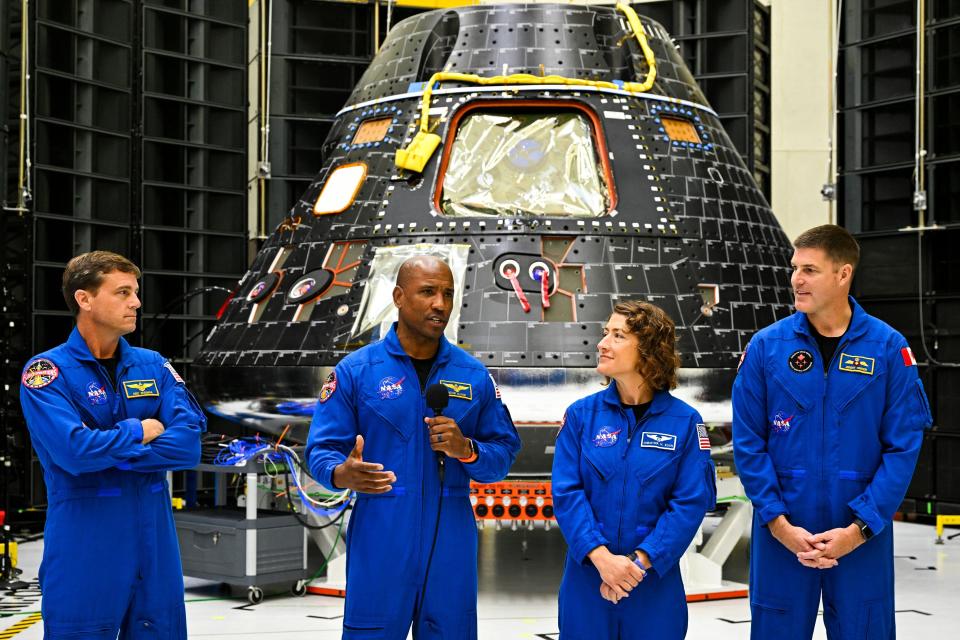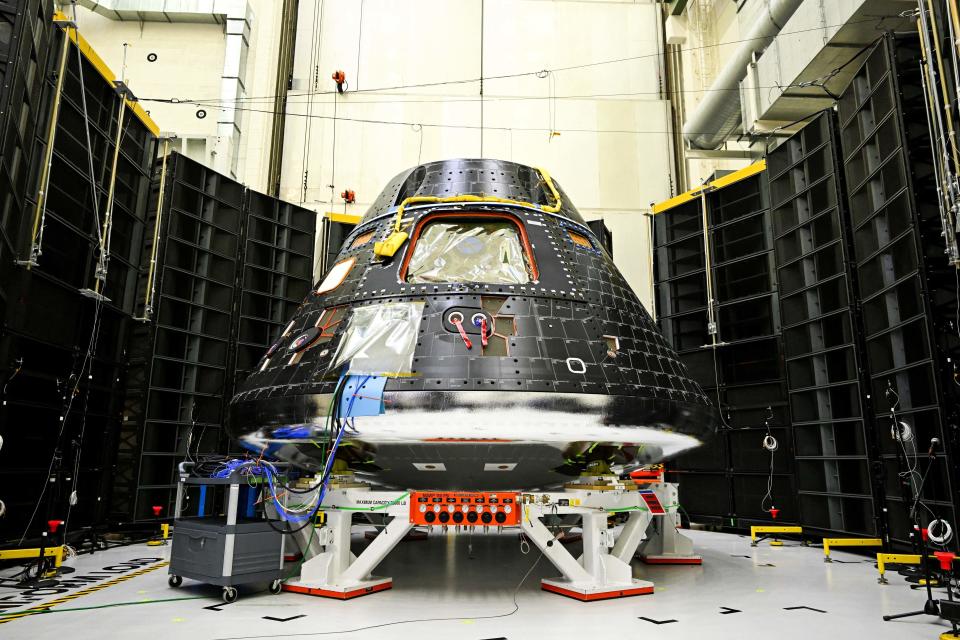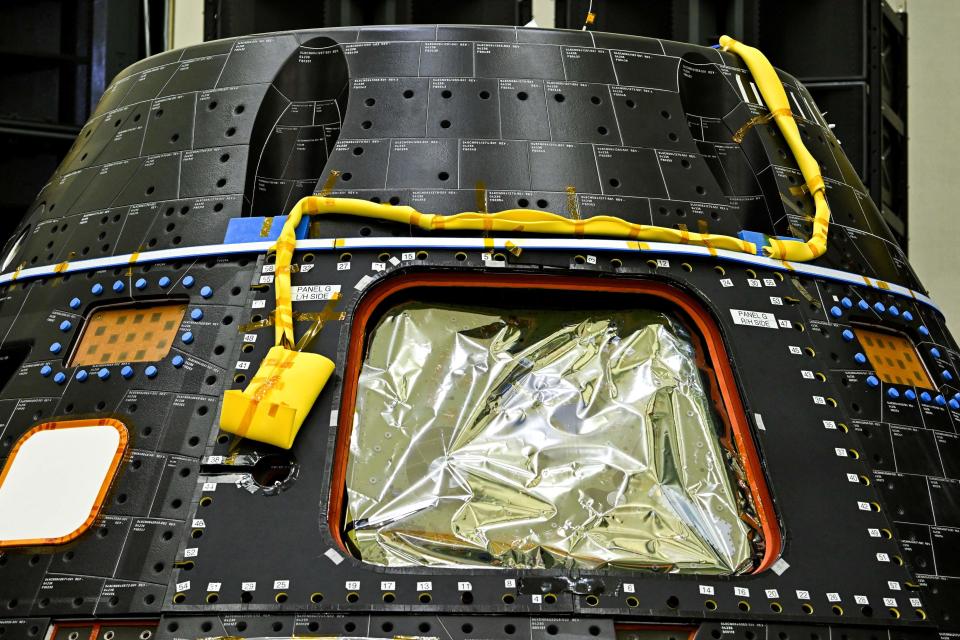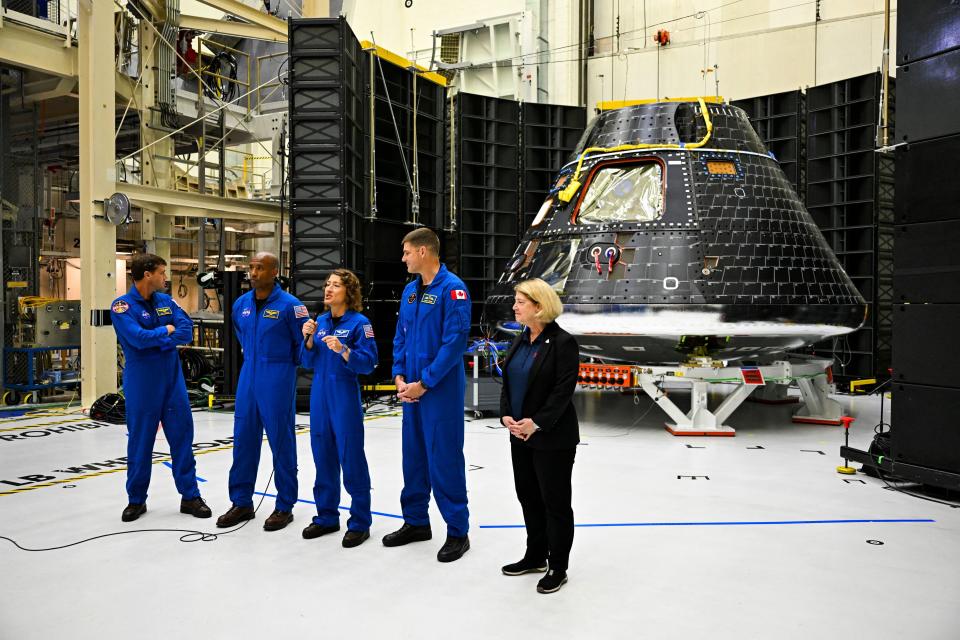To the moon and back: Astronauts get 1st look at Artemis II craft ahead of lunar mission
- Oops!Something went wrong.Please try again later.
The four Artemis II crew members who will be the first astronauts the United States has sent to the moon in a half-century got their first glimpse this week of the spacecraft that will take them there.
The imposing cone-shaped Orion capsule loomed on Tuesday inside a bay at NASA’s Kennedy Space Center in Florida as the crew inspected the craft and met the men and women charged with preparing it for spaceflight. In about a year's time, the crew of three Americans and one Canadian hope to board the capsule that will take them on a 10-day journey around the moon.
"We're fired up," astronaut Reid Wiseman said after checking out the capsule. "It's a great day yesterday when you walk around the corner at the Neil Armstrong Operations and Checkout facility and there's your spacecraft that you're going to ride in."

"At the threshold:' How UFOs became mainstream in America
What is the mission of Artemis II?
The venture will be the first crewed lunar mission in decades and serves as a catalyst for future moon exploration, according to NASA.
When the spacecraft launches from Cape Canaveral, Florida, it will take the four astronauts on a journey spanning 600,000 miles to the moon and back.
The main purpose of the mission is to test the capabilities of NASA's Space Launch System rocket and a crewed Orion spacecraft needed for deep space exploration ahead of Artemis III. That later mission is slated for launch in 2025 and would put two astronauts on the surface of the moon for the first time since the last Apollo mission in 1972.
"There's a renewed interest in the moon," NASA Administrator Bill Nelson said Tuesday before assembled news media. "The fact that the crew has seen their spacecraft now, this is another major step of us going back to the moon."
The Artemis III crew is intended to land at the moon's south polar region, where they will stay for about one week. Ultimately, NASA aims to establish a permanent human presence on and around the moon as it prepares for future missions to Mars.
Though the names of the crew members for Artemis III have not been revealed, NASA has said they will be the first woman and first person of color to land on the moon.
Mid-Atlantic meteor: 'Most impressive fireball I have ever witnessed'

When will Artemis II launch?
The Artemis II mission is scheduled to launch in November 2024, but NASA has plenty of work ahead before that happens — and any hiccups or unforeseen obstacles could delay it.
Last year, NASA performed a 26-day test flight of the Orion spacecraft ending Dec. 11 with no one aboard for its Artemis I mission. Orion is the only spacecraft capable of returning crews to Earth at lunar-reentry velocities, and NASA wanted to test its heat shield under extreme reentry conditions.
The spacecraft is undergoing acoustic testing prior to integration with its service module, the next major step in the assembly process, NASA said Tuesday.
The Artemis III also saw a setback in April when Elon Musk's SpaceX Starship rocket exploded about four minutes after launch, breaking apart in a fiery explosion over the Gulf of Mexico. However, Musk still considered the mission a success since the main goal was for the rocket's engines to ignite and for the vehicle to clear the tower.

Anything else, SpaceX said at the time, meant extra data for engineers to review.
In 2021, NASA awarded SpaceX a $2.9 billion contract to develop the first commercial human lander that will ferry the two American astronauts from orbit to the lunar surface.
Luna-25: NASA said its orbiter likely found the crash site of Russia's failed Luna-25 moon mission

The month after the Starship explosion, NASA announced that it had tapped Blue Origin as the second company to develop a human lunar lander system for Artemis missions. Owned and personally funded by billionaire Jeff Bezos, Blue Origin was selected to deliver astronauts to the lunar surface for the space agency's Artemis V mission, slated for no earlier than 2029.
In the meantime, the Artemis II crew has been training for the mission and last month visited Naval Base San Diego ahead of a recovery test in the Pacific Ocean. The July 19 test was meant to ensure NASA and Department of Defense personnel will be prepared to safely recover the four astronauts and their Orion spacecraft when they splash down upon return to Earth.
Meet the astronauts of Artemis II

Announced in April, the crew consists of three Americans and one Canadian from the Canadian Space Agency. Among them is the first woman and first African American assigned to a lunar mission.
Reid Wiseman: Named mission commander of Artemis II, Wiseman previously worked on the International Space Station in 2014, where he and his crew set a milestone for station science by completing a record 82 hours of research in a single week. Wiseman has also served as Chief of NASA Astronauts.
Victor Glover: Glover will pilot the Artemis II mission after logging 3,000 flight hours in more than 40 different aircraft. He most recently served as pilot and second-in-command on the Crew-1 SpaceX Crew Dragon, named Resilience.
Christina Hammock Koch: A mission specialist on Artemis II, Koch served as a flight engineer aboard the International Space Station and made waves in the first all-woman spacewalk. Koch also holds the record for the longest single spaceflight by a woman with a total of 328 days.
Jeremy Hansen: A member of the Canadian Space Agency, Hansen is a former fighter pilot and works with NASA in training astronauts. He'll serve as a mission specialist on Artemis II.
Eric Lagatta covers breaking and trending news for USA TODAY. Reach him at elagatta@gannett.com.
This article originally appeared on USA TODAY: NASA astronauts see Artemis II craft ahead of trip around the moon

